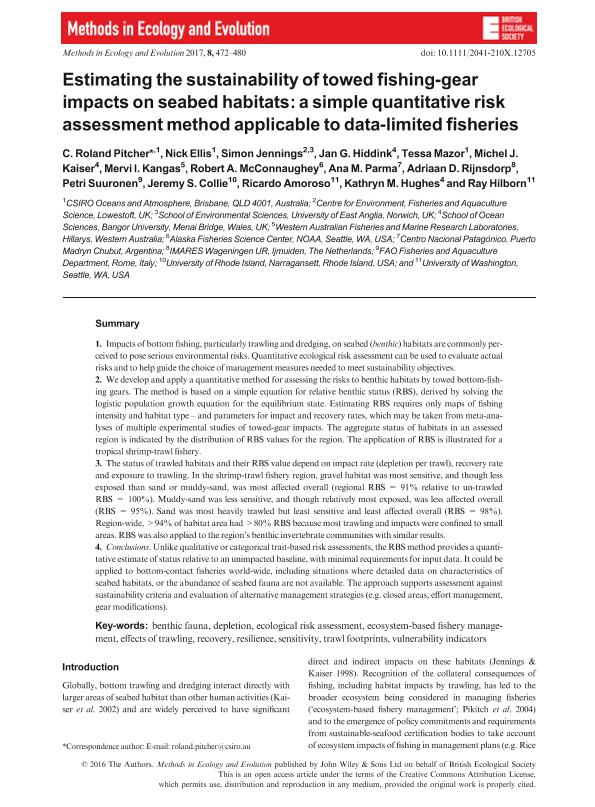Mostrar el registro sencillo del ítem
dc.contributor.author
Pitcher, C. Roland
dc.contributor.author
Ellis, Nick
dc.contributor.author
Jennings, Simon
dc.contributor.author
Hiddink, Jan G.
dc.contributor.author
Mazor, Tessa
dc.contributor.author
Kaiser, Michel J.
dc.contributor.author
Kangas, Mervi
dc.contributor.author
McConnaughey, Robert A
dc.contributor.author
Parma, Ana María

dc.contributor.author
Rijnsdorp, Adriaan D.
dc.contributor.author
Suuronen, Petri
dc.contributor.author
Collie, Jeremy S.
dc.contributor.author
Amoroso, Ricardo Oscar

dc.contributor.author
Hughes, Kathryn M.
dc.contributor.author
Hilborn, Ray
dc.date.available
2017-09-22T18:38:21Z
dc.date.issued
2016-11
dc.identifier.citation
Pitcher, C. Roland; Ellis, Nick; Jennings, Simon; Hiddink, Jan G.; Mazor, Tessa; et al.; Estimating the sustainability of towed fishing-gear impacts on seabed habitats: a simple quantitative risk assessment method applicable to data-limited fisheries; British Ecological Society; Methods in Ecology and Evolution; 8; 11-2016; 472-480
dc.identifier.issn
2041-210X
dc.identifier.uri
http://hdl.handle.net/11336/24954
dc.description.abstract
Impacts of bottom fishing, particularly trawling and dredging, on seabed (benthic) habitats are commonly per-ceived to pose serious environmental risks. Quantitative ecological risk assessment can be used to evaluate actualrisks and to help guide the choice of management measures needed to meet sustainability objectives.2.We develop and apply a quantitative method for assessing the risks to benthic habitats by towed bottom-fish-ing gears. The method is based on a simple equation for relative benthic status (RBS), derived by solving thelogistic population growth equation for the equilibrium state. Estimating RBS requires only maps of fishingintensity and habitat type–and parameters for impact and recovery rates, which may be taken from meta-ana-lyses of multiple experimental studies of towed-gear impacts. The aggregate status of habitats in an assessedregion is indicated by the distribution of RBS values forthe region. The application of RBS is illustrated for atropical shrimp-trawl fishery.3.The status of trawled habitats and their RBS value depend on impact rate (depletion per trawl), recovery rateand exposure to trawling. In the shrimp-trawl fishery region, gravel habitat was most sensitive, and though lessexposed than sand or muddy-sand, was most affected overall (regional RBS = 91% relative to un-trawledRBS = 100%). Muddy-sand was less sensitive, and thoughrelatively most exposed, was less affected overall(RBS = 95%). Sand was most heavily trawled but least sensitive and least affected overall (RBS = 98%).Region-wide, >94% of habitat area had >80% RBS because most trawling and impacts were confined to smallareas. RBS was also applied to the region’s benthic invertebrate communities with similar results.4.Conclusions. Unlike qualitative or categorical trait-based risk assessments, the RBS method provides a quanti-tative estimate of status relative to an unimpacted baseline, with minimal requirements for input data. It could beapplied to bottom-contact fisheries world-wide, including situations where detailed data on characteristics ofseabed habitats, or the abundance of seabed fauna are not available. The approach supports assessment againstsustainability criteria and evaluation of alternative management strategies (e.g. closed areas, effort management,gear modifications).
dc.format
application/pdf
dc.language.iso
eng
dc.publisher
British Ecological Society
dc.rights
info:eu-repo/semantics/openAccess
dc.rights.uri
https://creativecommons.org/licenses/by-nc-sa/2.5/ar/
dc.subject
Benthic Fauna
dc.subject
Depletion
dc.subject
Ecological Risk Assessment
dc.subject
Ecosystem-Based Fishery Management
dc.subject
Effects of Trawling
dc.subject
Recovery
dc.subject
Resilience
dc.subject
Sensitivity
dc.subject
Trawl Footprints
dc.subject
Vulnerability Indicators
dc.subject.classification
Agricultura

dc.subject.classification
Agricultura, Silvicultura y Pesca

dc.subject.classification
CIENCIAS AGRÍCOLAS

dc.title
Estimating the sustainability of towed fishing-gear impacts on seabed habitats: a simple quantitative risk assessment method applicable to data-limited fisheries
dc.type
info:eu-repo/semantics/article
dc.type
info:ar-repo/semantics/artículo
dc.type
info:eu-repo/semantics/publishedVersion
dc.date.updated
2017-06-30T13:29:05Z
dc.journal.volume
8
dc.journal.pagination
472-480
dc.journal.pais
Estados Unidos

dc.journal.ciudad
Hoboken
dc.description.fil
Fil: Pitcher, C. Roland. CSIRO; Australia
dc.description.fil
Fil: Ellis, Nick. CSIRO; Australia
dc.description.fil
Fil: Jennings, Simon. Fisheries and Aquaculture Science; Reino Unido. University Of East Anglia; Reino Unido
dc.description.fil
Fil: Hiddink, Jan G.. Bangor University; Reino Unido
dc.description.fil
Fil: Mazor, Tessa. CSIRO; Australia
dc.description.fil
Fil: Kaiser, Michel J.. Bangor University; Reino Unido
dc.description.fil
Fil: Kangas, Mervi. Western Australian Fisheries and Marine Research Laboratories; Australia
dc.description.fil
Fil: McConnaughey, Robert A. National Ocean And Atmospheric Administration. Alaska Fisheries Science Center; Estados Unidos
dc.description.fil
Fil: Parma, Ana María. Consejo Nacional de Investigaciones Científicas y Técnicas. Centro Científico Tecnológico Conicet - Centro Nacional Patagónico; Argentina
dc.description.fil
Fil: Rijnsdorp, Adriaan D.. IMARES Wageningen UR; Países Bajos
dc.description.fil
Fil: Suuronen, Petri. FAO Fisheries and Aquaculture Department; Italia
dc.description.fil
Fil: Collie, Jeremy S.. University of Rhode Island; Estados Unidos
dc.description.fil
Fil: Amoroso, Ricardo Oscar. University of Washington; Estados Unidos
dc.description.fil
Fil: Hughes, Kathryn M.. Bangor University; Reino Unido
dc.description.fil
Fil: Hilborn, Ray. University of Washington; Estados Unidos
dc.journal.title
Methods in Ecology and Evolution
dc.relation.alternativeid
info:eu-repo/semantics/altIdentifier/doi/http://dx.doi.org/10.1111/2041-210X.12705
dc.relation.alternativeid
info:eu-repo/semantics/altIdentifier/url/http://onlinelibrary.wiley.com/doi/10.1111/2041-210X.12705/abstract
Archivos asociados
